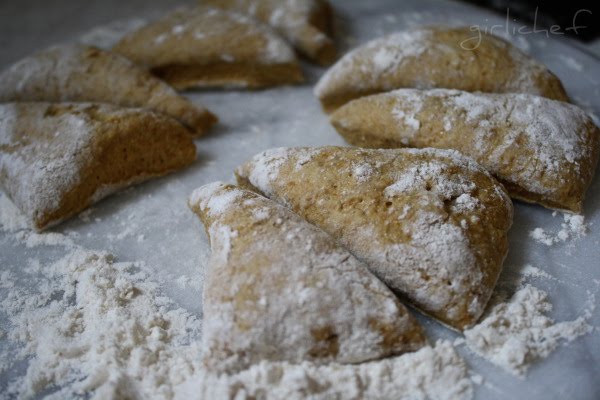

I think apricot jam is underrated. Well, it always was by me, at least. Not sure why. Perhaps because I always used it as an understudy, as opposed to letting it be the star. The jam I've tried has always been fairly, well...neutral. Dull. Uneventful. Not worth writing home about. I used it to "seal" the crumb of a cake or melted it in preparation for glazing fruit on a tart or cake. Maybe it's that I never really took the time to get to know the apricot itself. I mean sure, I love snacking on dried apricots...but it's not often I grab an apricot to just eat out-of-hand. I hardly ever see them fresh. Maybe for a fleeting moment. The ones at grocery stores are cultivated for shipping. Picked hard and pale and tasteless. No wonder apricots have been all but forgotten in their "natural" state. In the last year or so I've seen some really pretty, tempting, little apricoty-orange ones popping up at the farmer's market. I decided these little beauties needed their name in lights! Did you know that apricots do NOT continue to ripen after they're plucked from the tree? No wonder they lost their appeal stuck amidst the hard peaches and mealy apples in the supermarket. BUT, if plucked ripe and sagging from the tree...expect a burst of golden juice when you take that first bite...some juice dribbling from your lips because you don't have time to close them before it bursts! What a pleasant surprise. A star is born!
Okay, so now that I actually know an apricot has a flavor of its own, what do I do with it? Turn it into jam.
HA! But, jam that's rich and caramely and golden orange...with a hint of bitter almond. Jam that begs to be spooned onto toast or layered into a tart. Or just eaten straight. Seriously. It was so tasty, I ate it from the spoon.
Let's talk first about that bitter almond flavor I adore so much. Did you know that it comes from the pit of an apricot? I didn't. Basically the flavor is stuck inside the kernel that lies inside the pit of an apricot. The flavor that can also be
deadly! That's right...what else do you think of when you think bitter almond flavor? Cyanide! Yikes! The kernel, actual name Noyaux, contains an enzyme that when mixed with water makes prussic acid. Poison. Why in the world, then, is that flavor so desireable?
Have you tasted amaretto? YUM. That's why. Fortunately, there's a way to safeguard against accidentally poisoning yourself and your loved ones. Roasting the noyaux kills that enzyme. It's a simple process, too. First, cut the apricot in half...just follow the natural
butt-crack and make your way around. Oh come on...you know it looks like a cute, fuzzy little bootie. Okay, remove the pit. Rinse all the stuck on apricot from the pits and place them on a sheet/pan and roast them in a 350 degree F oven for ~15 minutes. Now, crack open the pits to extract the kernel (noyaux). But be prepared- the kernel is hard! It's like trying to crack a walnut or an almond from its shell. Use a hammer or the butt end of the knife...or a nutcracker. Now, stick 'em back in the oven and roast them for another 10 minutes or so. Better to be safe than dead. Chop them up and they're ready to use.
Bitter Almond Flavored Apricot Jam
from Chez Panisse Fruit by Alice Waters
makes 4 c.
2 1/2 lbs. apricots, pitted and cut into 1/2" chunks
3 c. sugar
Noyaux (apricot kernels *see above)- 10 or fewer
Juice of 1 lemon
Stir the diced apricots and sugar together in a large heavy-bottomed nonreactive pot. Let the mixture stand at least 30 minutes, to overnight...this will let the apricots release their juices and the sugar dissolve. Chop up your noyaux and add to the fruit and sugar (they are strong, so don't use more than 10 for a batch this size). Put a small plate in freezer to use later for checking the consistency of the jam.
Prepare four 8-oz. canning jars and self-sealing lids, per manufacturer's directions.
Bring the pot of fruit to a boil over high heat, stirring occasionally to make sure it isn't sticking to the bottom. The mixture will bubbleup dramatically, rising high up the sides of the pot. Skim off any light-colored foam that rises and collects on the sides. Soon the jam will boil down, forming smaller, thicker bubbles. At this point, start testing for consistency by putting a small spoonful of jam on the plate. This will cool off the jam sample quickly so you can tell what finished texture will be like. When the jam has cooked to the thickness you want, stir in the lemon juice. Turn off heat and carefully ladle the jam into the prepared canning jars, allowing at least 1/4" of headroom. Seal, per manufacturer's instructions. The jam will keep for about a year. Alternately, make a smaller batch and keep it in the fridge or use it right away.

If you're nervous about using the noyaux, you can leave it out. My first few bites I felt all tingly...kind of like my throat was closing up. I felt sort of anxious and my mouth was watering. Now, I roasted those kernels like there was no tomorrow...but I think it was sort of a placebo-effect sort of thing. Or perhaps there was a bit of that toxin still in there...the feeling some one is said to get from eating Fugu (Pufferfish). I may never know. The important this is...I'm still here. Writing this post and drooling once again over apricot jam that is packed full of bitter almond and rich caramel notes...with pleasant chunks of actual fruit!
It's Tuesday, and you know what that means! Or do you? It's time for another round of
Two for Tuesdays Blog Hop Carnival!
 Add your REAL FOOD link
Add your REAL FOOD link at the bottom of this post and
then leave a comment so I know you've joined in this week! And remember, your link will show up at all 4 host sites for
Two for Tuesdays! Thanks for making and eating REAL food and sharing it with us.
*If you missed the Two for Tuesdays announcement and wonder what it's all about, just click on the badge or HERE and it'll take you to the explanation page!!
I am also submitting this to Tuesday Twister at Gnowfglins and Real Food Wednesdays at Kelly the Kitchen Kop.








































